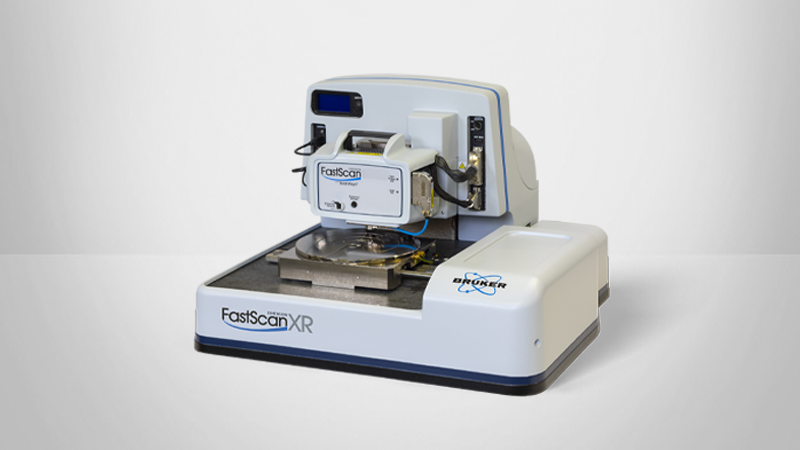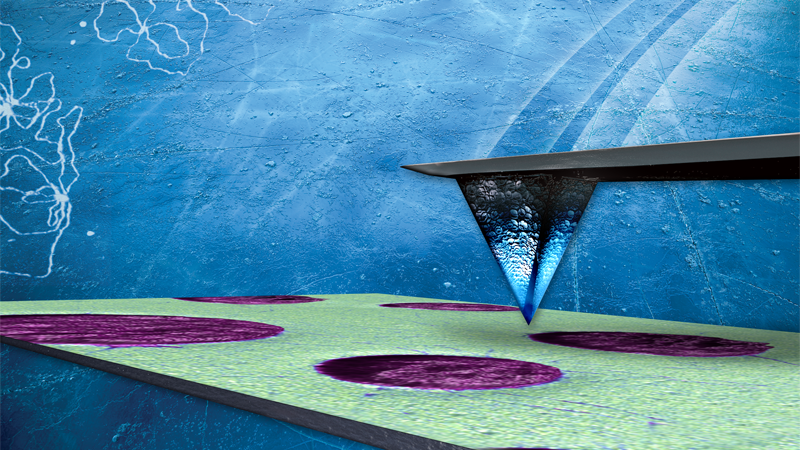Ringing Mode
Ringing Mode is a powerful extension of PeakForce Tapping that provides new insights through multidimensional imaging; it simultaneously records up to 8 new quantitative compositional imaging channels in a single scan, extending PeakForce QNM studies with rich and complementary data. This sub-resonant mode:
- Enables nanoscale mapping of previously inaccessible information on surface adhesion properties of materials;
- Provides exclusive access to new data channels through unique utilization of the ringing portion of peak force feedback signal; and
- Integrates seamlessly on Bruker AFM systems.
Integrated as a single AFM operational mode, Ringing Mode and PeakForce QNM together provide a more comprehensive solution for nanoscale characterization.
Enabling Enhanced Surface Adhesion Property Mapping
The ringing signal resulting from surface detachment of the AFM probe has previously had limited emphasis. Unlike any other existing AFM mode, Ringing Mode utilizes this rich signal to provide new insights into the often-complex unbinding process of surface molecules.
As a result, Ringing Mode delivers 8 new quantitative compositional imaging channels. This extends the available data in PeakForce QNM to provide up to 14 available different data types, including the standard nanomechanical property channels. Ringing Mode expands on the unique strengths of PeakForce QNM to provide enhanced adhesion property information that is complementary to existing mechanical and structural data.
Ringing Mode's unique compositional imaging channels include:
- Restored Adhesion
- Adhesion Height
- Zero-force Height
- Disconnection Height
- Pull-off Neck Size
- Disconnection Distance
- Disconnection Energy Loss
- Dynamic Creep Phase Shift
Providing New & Complementary Surface Property Information for Materials
Neck Formation in Soft Matter
Measuring the maximum height of the neck pulled from a sample surface during probe retraction, Pull-Off Neck Size provides insights into processes, such as polymer necking or membrane tubule formation in cells. This extends PeakForce QNM mechanical property information to provide information on tensile deformation of surface layers at the nanoscale.
Extension Length of Surface Molecules
Disconnection Distance measures the length of molecules stretched from the surface by the AFM probe, such as those found in polymer coatings or cell membranes. These nanoscale maps can provide key information as to the surface distribution and organization of soft, flexible molecules that are not easily imaged by other techniques.
High-Resolution Imaging of Surface Molecules
Ringing Mode enables highly accurate nanoscale compositional mapping of sample surfaces, including the distribution of surface coating molecules, with nanometer spatial resolution. This is due to minimization of tip-sample contact size that happens at the disconnection point.
Energy Dissipation During Tip-Sample Interaction
During interaction of the AFM probe with the sample surface, energy is dissipated due to (1) adhesion energy, (2) energy due to the viscous response of the sample material during the contact deformation, and finally, (3) disconnection energy loss. PeakForce QNM Dissipation Energy provides the sum of all energy contributions. Ringing Mode separately measures Disconnection Energy Loss, which is most closely associated with the surface layer or surface molecules rather than distortion of the bulk sample material.
Enriched Adhesion Information
AFM adhesion measurements typically consider overall tip-sample detachment (pull-off force). Restored Adhesion focuses only on the adhesive forces involved in detachment of residual surface molecules or molecular tails after the AFM tip has lost adhesive contact with the sample surface.
Extending Your PeakForce Tapping Studies
With seamless hardware and software integration, use of Bruker’s exclusive probes, and ‘one-click’ calibration, Ringing Mode easily expands your PeakForce QNM experiments and, for the first time, unlocks new possibilities for investigating the adhesive properties of materials at the nanoscale.
Ringing Mode is fully compatible with Bruker’s Performance Line of SPM systems.
Developed by Prof. Igor Sokolov and Dr. Maxim Dokukin (Tufts University) and presented to the market by Nanoscience Solutions Inc., Ringing Mode utilizes the same sub-resonant peak force feedback signal as PeakForce QNM to take advantage of the precise force control and separately measured adhesion but focuses on the ringing portion of the signal resulting from surface detachment of the AFM cantilever to extract key information regarding adhesion and unbinding events. Click here to read more about Ringing Mode on the Nanoscience Solutions, Inc. site.




